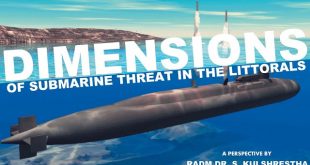Introduction:
The US Defense Advanced Research Projects Agency (DARPA) is taking bold steps to address a critical challenge in marine vehicle design – drag. The newly initiated Drag Reducing Architected Geometries (DRAG) program is set to redefine the capabilities of ships, submarines, and unmanned underwater vehicles (UUVs) by reducing drag, and enhancing speed, range, and fuel efficiency. In this article, we explore the DRAG program and its potential to revolutionize marine vehicle design.
Reducing Drag for Enhanced Performance:
Drag is a formidable barrier that hinders the speed, range, and efficiency of marine vehicles. With the goal of overcoming the effects of drag at sea, the US Defense Advanced Research Projects Agency (DARPA) announced its Drag Reducing Architected Geometries (DRAG) programme on 8 September 2023. This would enable increased speed and endurance, while reducing fuel use and emissions.
DARPA’s DRAG program aims to tackle this issue by focusing on architected geometries. The effort will focus on novel solutions that reduce drag on flat, curved, and complex surfaces. These are micrometer-scale structures engineered to achieve specific properties that can disrupt water flow around an object. By incorporating these architected geometries, DARPA aims to unlock new possibilities for marine platforms.
“Previous research has enabled ship drag reduction in laminar flow conditions but not in transition and fully turbulent flow,” said Dr. Susan Swithenbank, programme manager in DARPA’s Defense Sciences Office.
“With the availability of new modeling tools and the ability to optimise highly complex shapes, we’re now seeking novel approaches to achieve a breakthrough in more challenging turbulent flow conditions, where the drag coefficient is much higher. For naval vehicles you either need more power or less drag to go farther.
“The problem with adding power is that it means you need more batteries, fuel, or a bigger engine, which increases the size of your ship or UUV, adding more drag. We aim to lower the drag coefficient to allow increased speed without increasing power or to go the same speed using less power.”
Shark-Inspired Designs:
The programme will explore various material structures, shapes, and coatings to decrease friction where water contacts the hull. DRAG is not focused on biofouling mitigation, development of new hull materials, manufacturing scale-up, or methods that require active air and/or polymer injection.
The solicitation adds that “performers will develop a surface optimization modeling and simulation design tool to enable tailoring of architected surface solutions for reducing drag.”
In the initial phase, researchers found that some of the most effective architected geometries were inspired by sharkskin. The unique ridges and grooves on sharkskin disrupt water flow and reduce drag around the shark’s body. These biomimetic designs hold great promise in minimizing drag for marine vehicles.
Program Phases:
The DRAG program spans four years and is divided into two key phases. The first phase involves laboratory testing and development of various architected geometries. Researchers aim to identify the most effective geometries for reducing drag. The second phase entails testing these promising geometries on full-scale marine vehicles, including ships, submarines, and UUVs. The US Department of Defense (DoD) limited the total award value for Phase 1 (feasibility study) and Phase 2 (proof of concept) to $1m according to its solicitation on SAM.gov.
Promising Developments:
While specific results from the second phase are yet to be disclosed, DARPA has reported “very promising” outcomes. The architected geometries have demonstrated their potential to significantly reduce drag on marine vehicles, opening the door to improved performance and efficiency.
Industry Collaborations:
DARPA has joined forces with industry giants to advance the DRAG program. Boeing is working on shark-inspired submarine coatings, while Lockheed Martin is developing drag-reducing UUV hulls. In 2024, full-scale ship testing will commence, involving collaboration with shipbuilders to develop innovative hulls and coatings.
Transforming Marine Vehicle Design:
The DRAG program has the potential to revolutionize marine vehicle design and performance. By reducing drag, architected geometries could enable faster and more fuel-efficient ships, stealthier submarines, and UUVs with longer ranges and endurance. This program also holds the promise of reducing fuel consumption and environmental impact, enhancing military platform stealth and performance, and ensuring greater safety and reliability in marine operations.
Conclusion:
DARPA’s DRAG program represents a groundbreaking initiative that could redefine the possibilities for marine vehicles. By harnessing the power of architected geometries to reduce drag, DARPA is ushering in a new era of highly capable and efficient marine platforms. The program’s progress continues to inspire optimism for the future of marine vehicle design and performance.
References and Resources also include:
https://www.naval-technology.com/news/darpa-sets-up-project-to-overcome-the-effects-of-drag/?cf-view
 International Defense Security & Technology Your trusted Source for News, Research and Analysis
International Defense Security & Technology Your trusted Source for News, Research and Analysis
